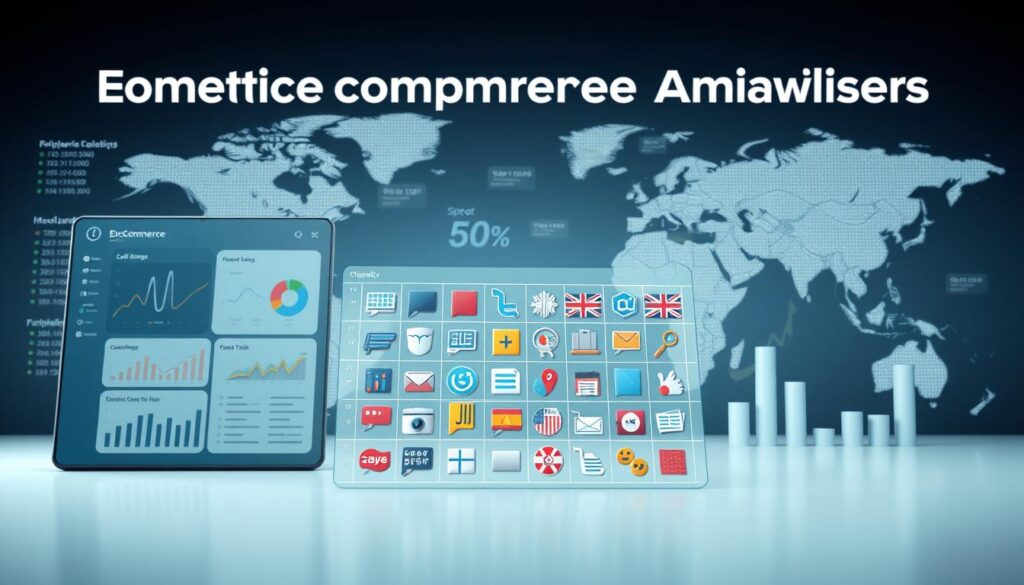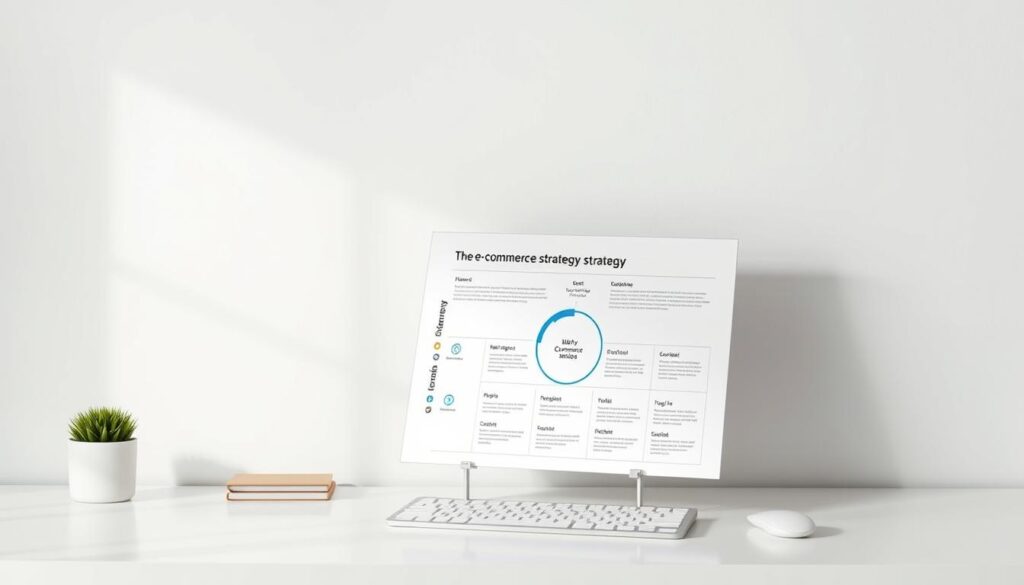Most leaders agree that strategic planning drives business growth, but execution remains elusive. A 2022 Harvard Business Review study reveals 85% of executives prioritize effective go-to-market approaches, yet only 29% successfully implement them. This gap highlights a critical opportunity for digital sellers ready to refine their playbooks.
Digital commerce demands more than basic online listings. Consumer behaviors shift rapidly, and outdated methods struggle to deliver consistent results. Companies combining data-driven decision-making with adaptable frameworks achieve 33% higher revenue target attainment, proving structured strategies outperform guesswork.
This guide tackles modern challenges through actionable solutions. It bridges planning and execution by aligning digital marketing innovations with time-tested principles. Readers gain tools to prioritize resources, select high-impact channels, and create sustainable growth cycles.
Key Takeaways
- Strategic execution gaps create advantages for proactive businesses
- Hybrid approaches outperform purely traditional or digital methods
- Revenue target achievement increases by 33% with structured planning
- Consumer behavior shifts demand real-time strategy adjustments
- Resource allocation directly impacts customer acquisition costs
Introduction: The Need for a Strategic E-commerce Launch
Digital product launches face 45% higher failure rates than traditional retail rollouts, according to 2023 industry data. This gap underscores why structured planning isn’t optional – it’s the lifeline for sustainable growth in competitive online spaces.
| Element | Ad-Hoc Approach | Strategic Approach |
|---|---|---|
| Success Rate | 31% | 67% |
| Time to Market | 9-12 weeks | 4-6 weeks |
| Resource Waste | 42% average | 11% average |
| Customer Retention | 28% after 90 days | 61% after 90 days |
Companies using integrated launch strategies reduce customer acquisition costs by 38% while achieving 2.3x faster revenue growth. The key lies in aligning product development cycles with real-time market feedback loops.
Three critical mistakes derail most launches:
- Treating digital channels as isolated silos
- Underestimating cross-department dependencies
- Failing to update strategies mid-campaign
Recent case studies show businesses combining agile testing frameworks with robust analytics achieve 79% higher launch success rates. This approach turns potential risks into measurable opportunities.
The Importance of a Proactive Go-to-Market Approach
Forward-thinking companies don’t wait for market shifts—they shape them. Businesses using structured strategies achieve 30% higher revenue growth and profitability compared to peers relying on reactive tactics. This gap reflects how anticipation beats adaptation in fast-moving digital environments.

Early movers secure competitive advantages by identifying high-potential channels before rivals do. Research shows brands entering markets strategically reduce customer acquisition costs by 38% while building stronger brand recognition. These leaders create entry barriers through targeted resource allocation and audience-specific messaging.
Predictive planning transforms guesswork into measurable outcomes. Organizations analyzing past performance data forecast sales trends 47% more accurately than those using intuition alone. “Agile frameworks paired with real-time analytics let teams pivot campaigns before losses compound,” notes a 2023 retail technology report.
Three principles separate proactive approaches from outdated methods:
- Channel optimization based on performance thresholds
- Continuous feedback loops with core customer segments
- Budget flexibility for emerging technologies
This methodology doesn’t just prevent crises—it uncovers hidden growth opportunities. Companies updating strategies quarterly see 22% faster market share expansion than annual planners. In digital commerce, sustained success requires treating strategy as a living process, not a one-time checklist.
Understanding Go-to-Market Strategies for E-commerce
Modern digital sellers face a paradox: abundant data yet fragmented execution. A structured approach bridges this gap by aligning teams, tools, and timelines. Let’s examine how comprehensive planning frameworks create measurable advantages in crowded marketplaces.
Definition and Scope of GTM Strategies
A go-to-market strategy acts as a blueprint for introducing offerings. Unlike traditional plans, it combines cross-functional workflows with real-time performance tracking. For digital sellers, this means synchronizing inventory systems, payment gateways, and customer support channels.
The scope extends beyond initial sales. Effective strategies map the entire customer journey—from discovery emails to post-purchase surveys. Brands using integrated frameworks report 41% faster resolution of logistical bottlenecks compared to siloed teams.
Benefits for New Product Launches
Strategic launches reduce guesswork through predictive analytics. Companies analyzing historical conversion patterns achieve 28% higher early adoption rates. Metrics like customer lifetime value become actionable when tied to channel performance.
Three measurable outcomes emerge from structured approaches:
- 53% faster identification of high-converting audiences
- 37% reduction in wasted ad spend through automated bidding
- 22% improvement in repeat purchase rates via retention workflows
Platforms leveraging smart automation tools see 19% higher margins within six months. By treating strategy as dynamic rather than static, businesses adapt to shifting consumer behaviors without sacrificing momentum.
Key Components of a go to market e-commerce Strategy
What separates thriving digital sellers from those struggling to gain traction? The foundation lies in precise market research and competitor intelligence—tools that transform assumptions into actionable strategies. Businesses using structured frameworks achieve 48% faster identification of high-value opportunities compared to those relying on surface-level data.

Leveraging Market Research and Competitive Analysis
Effective research starts by decoding digital footprints. Analyze search trends, cart abandonment rates, and mobile engagement patterns to uncover hidden customer needs. One retail brand increased conversions by 33% after discovering 62% of their audience preferred video demonstrations over text guides.
Competitor evaluation goes beyond price tracking. Examine how rivals structure loyalty programs, handle returns, and personalize email campaigns. A recent study shows companies monitoring three or more competitors reduce pricing errors by 41%.
| Approach | Reactive | Proactive |
|---|---|---|
| Customer Insights | Basic demographics | Behavioral analytics |
| Competitor Tracking | Monthly price checks | Real-time tool alerts |
| Strategy Updates | Annual revisions | Quarterly pivots |
Establishing Your Sales Proposition
Clarity wins in crowded markets. A strong value statement answers two questions: Why does your solution matter now? What makes it irreplaceable? Brands that articulate specific outcomes (“Saves 9 hours weekly” vs. “Improves efficiency”) see 27% higher click-through rates.
“The best propositions mirror customer language while highlighting overlooked differentiators,” notes a 2023 e-commerce trends report. Pair quantitative benefits with emotional triggers—89% of buyers remember stories over statistics.
Continuous testing refines your message. A/B test value statements across platforms, using heatmaps to identify which elements drive decisions. Companies adopting this method achieve 19% faster customer acquisition cycles.
Identifying Your Target Audience and Shaping Buyer Personas
Precision beats assumptions when building customer profiles. Businesses using data-driven segmentation achieve 41% higher conversion rates than those relying on generic messaging. The secret? Treating audience analysis as a diagnostic tool rather than a checkbox exercise.
Segmenting by Demographics and Firmographics
Effective segmentation starts with quantifiable patterns. Age ranges and income brackets reveal surface-level trends, while technology adoption rates and mobile usage habits expose deeper behavioral drivers. For B2B sellers, firmographic analysis uncovers budget cycles and approval hierarchies that shape purchasing timelines.
| Approach | Basic | Advanced |
|---|---|---|
| Data Sources | Age/Gender | Scroll depth + Click maps |
| Insight Depth | Surface trends | Purchase intent signals |
| Impact | 12% lift | 34% lift |
Creating Detailed Buyer Profiles
Blend analytics with human insights. One outdoor gear brand discovered 68% of high-value customers watched product videos twice before buying. “Profiles should explain why decisions happen, not just what’s purchased,” notes a 2023 CX report.
Prioritize traits influencing digital behavior:
- Preferred content formats (video vs. text)
- Mobile vs desktop conversion rates
- Cart abandonment triggers
Teams updating profiles quarterly see 27% better campaign performance. This process turns abstract audiences into recognizable decision-makers.
Crafting a Unique Value Proposition for E-commerce Success
Standout brands don’t just sell products—they solve urgent problems. Research shows 73% of consumers choose brands whose core messages directly address their specific needs. A unique value proposition acts as this critical bridge between business offerings and buyer priorities.
Aligning Product Benefits with Consumer Needs
Effective value propositions translate technical features into tangible outcomes. For example, noise-canceling headphones become “focus enhancers for remote workers” rather than listing decibel reductions. This shift drives 29% higher conversion rates by answering “What’s in it for me?” upfront.
| Element | Effective UVP | Weak UVP |
|---|---|---|
| Benefit Clarity | “Saves 5 hours weekly” | “Advanced workflow solution” |
| Emotional Appeal | “Feel confident in crowded spaces” | “High-quality audio device” |
| Competitive Edge | Patented spill-proof design | Durable construction |
| Adaptability | Updates based on user feedback | Static feature list |
Successful propositions balance functional and emotional triggers. A 2023 Forrester report found campaigns addressing both aspects achieve 41% higher retention than purely practical messaging. This dual focus helps brands stand out in saturated markets.
Continuous refinement separates lasting strategies from temporary wins. Companies reviewing value statements quarterly see 33% faster response to market shifts. Real-time A/B testing tools enable precise adjustments—changing a single word sometimes lifts click-through rates by 17%.
Consistency across channels remains vital. Whether shoppers encounter your brand through social ads or product pages, the core value should resonate instantly. Unified messaging builds trust while reducing cognitive load during decision-making.
Designing a Comprehensive Promotion and Marketing Plan
Brands with structured promotional frameworks achieve 43% higher engagement than those using scattered tactics. A cohesive strategy aligns channel selection, messaging, and timing to meet audiences where they’re most receptive. This approach transforms random acts of marketing into revenue-driving systems.
Selecting the Right Marketing Channels
Channel effectiveness depends on audience behavior rather than industry trends. Analyze click-through patterns and scroll depth data to identify platforms where prospects actively engage. For example, brands targeting Gen Z see 29% higher conversions on TikTok versus Facebook.
| Approach | Basic | Advanced |
|---|---|---|
| Channel Selection | Platform popularity | Conversion heatmaps |
| Content Format | Static posts | Interactive quizzes |
| Performance Lift | 14% | 37% |
Developing Campaign Messaging and Timelines
Consistent narratives require adapting core themes to each channel’s strengths. Email campaigns might emphasize detailed product specs, while Instagram focuses on lifestyle alignment. Companies using platform-specific messaging see 22% longer content engagement.
Timing impacts campaign success more than most realize. Launch holiday promotions 6-8 weeks before peak shopping dates, but test Black Friday offers in July to beat the rush. Brands scheduling based on purchase intent data reduce ad waste by 33%.
| Factor | Poor Planning | Strategic Timing |
|---|---|---|
| Customer Reach | 58% | 89% |
| Cost Per Click | $2.10 | $1.35 |
| Repeat Purchases | 19% | 41% |
Leveraging Digital Marketing and Social Media for Greater Reach
Connecting with modern consumers means meeting them where they spend their time. Integrated campaigns combining SEO fundamentals with platform-specific tactics achieve 47% higher engagement than single-channel efforts. This synergy turns casual browsers into loyal customers through strategic touchpoints.
Utilizing SEO and Content Marketing Techniques
High-performing websites treat content as a discovery engine. Answering common questions through blog posts and video guides improves search rankings while building trust. Brands optimizing for user intent see 33% more organic traffic within six months.
Technical SEO remains critical. Mobile-first indexing and structured data help products appear in featured snippets. Pair these with long-form guides addressing niche needs—this approach converts 22% better than generic product pages.
Engaging Audiences on Social Platforms
Social media success requires more than scheduled posts. Analyze platform algorithms to determine ideal posting times and formats. Instagram Reels users, for example, engage 41% longer with subtitled videos under 15 seconds.
Authenticity drives results. Responding to comments within 3 hours boosts follower growth by 29%. Use polls and Q&A features to turn passive viewers into active participants. These interactions provide valuable data for refining marketing channels and messaging.
FAQ
How does market research impact e-commerce strategy development?
Market research identifies customer pain points, competitor weaknesses, and emerging trends. Brands like Nike use consumer insights to tailor product launches, ensuring messaging aligns with audience expectations while avoiding assumptions about buyer behavior.
What distinguishes successful buyer personas in online retail?
Effective personas combine demographic data with behavioral patterns. Warby Parker’s approach includes analyzing purchase frequency, preferred platforms, and price sensitivity to create targeted campaigns that convert casual browsers into loyal customers.
Why is competitive analysis critical for digital sales positioning?
Analyzing competitors like Allbirds versus traditional footwear brands reveals gaps in sustainability messaging or pricing models. This intelligence helps craft unique value propositions that highlight underserved customer needs through specific product benefits.
Which marketing channels deliver the highest ROI for new product launches?
Platform selection depends on audience behavior. Glossier built its empire through Instagram engagement, while SEMrush dominates via LinkedIn thought leadership. Testing combinations of paid ads, influencer partnerships, and email nurturing optimizes channel performance.
How do brands measure e-commerce go-to-market success effectively?
Key metrics include conversion rates, customer acquisition costs, and lifetime value. Dollar Shave Club tracks repeat purchase patterns alongside social sentiment to assess both financial returns and brand perception shifts post-launch.
What role does SEO play in sustaining long-term market entry momentum?
Strategic keyword optimization ensures products remain visible post-launch. Companies like Chewy use evergreen content and product page updates to maintain organic search rankings, driving consistent traffic without continuous ad spend.
Can small businesses replicate enterprise-level go-to-market strategies?
Yes, through focused niche targeting. Brands like Bombas Socks achieved scale by concentrating on specific customer pain points (comfort + social impact) rather than competing broadly, using lean digital campaigns to maximize limited budgets.



